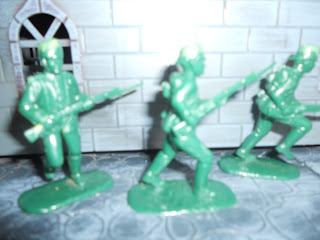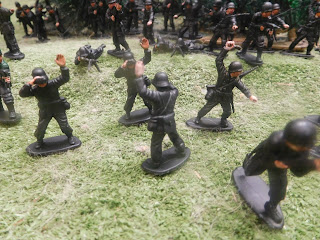Heroes Of The Beersteiners And Fezians In Aztecia. Character Identification And Traits.
The Beersteiner hero, Wolfgang Clink s captured by the Bogavanian Pikemen, who celebrate the event with a swig of ale. Wolfgang's impetuous charge led to the wiping out of his command and the death of a cleric. It is likely that King James will attempt to trade some Fezian POWs for the return of Wolfgang, although the Fezians might also try to turn him to serve Fezia and Bogavania. Despite being in his 60s Wolfgang still has good health and swordsmanship. (He is also rumored to dye his grey hair black). The armor is of a style of the ancients, also worn by Patrans (nation with remnants of ancient Egypt, Rome and Greece). There has been somewhat of an imitation of such ancient styles among some of the Beersteiners. This occurred a few years after the green Mist lifted from Patra's borders, allowing communication with other nations.
Fezian heroes Left to right: Faaid el-Shabazz, General Mamdooh el-Hag and Samir al Faris. Mat researched Muslim Middle Eastern names for his characters. (Mind you, Fezia has only the surface trapping of Islam as the people worship the Moon God!)
The general is thirty, a devout Lunarian and of excellent health. His battlefield intelligence and loyalty are average. (The lower the loyalty factor the easier for an enemy to try to convert a captured character to change sides. The percentage dice has to roll higher than the loyalty percentage. I might decide that this cannot be attempted until a certain number of map moves have transpired).
NOTES ON CHARACTERS
If one general has higher Battlefield Intelligence than his rival then the dice roles to see who is made to deploy first and to have first turn can be rerolled if they do not favor the general with better Battlefield Intelligence. Character qualities are determined with percentage dice. Other qualities to determine are degree of caution and degree of kindness. The former, if excessive may mean the commander is more likely to take his time in an advance or to not attack a larger enemy. The reverse can result in reckless charges.
A kind general is more likely to spare a village and not put POWs to the sword. The reverse is also possible with an outright sadistic leader.
Identification: I place labels under bases with names and some details about the characters. I also keep lists with qualities in old desk diaries. The characters have the edges of their bases painted red with some tasteful splotches of red on top, to make identification easier but to look like blood stains. The generals have purple around their base edges. Usually, I have generals mounted but neither Mat nor I upgraded our generals for the recent battle.
POWs
These are not Geneva Convention type societies so POWs might be used as slave labor or just killed. Characters who are POWs are likely to be sent to the capital and kept for exchange or ransom.
FIGURES
As the campaign scenario involves imagi-nations it allows for use of a very wide variety of figures, from ancient to English Civil War. In recent last game, set in a tropical land, I decided that armor would be limited to a cuirass, helmet and the odd other item. Conquistadors and ECW pike served for the heavier infantry but why not also include the odd ancient Roman or Greek? In fact the character, Conrad Richtoffen is going to have some more temperate climate add ons and some repainting into a more Renaissance look.
NAMES: Corny, yes, but my Beersteiner names were based on a few Germanic ones and famous people that came to mind. I mean I don't think Max Weber envisaged himself being a warrior with helmet, sword and, greaves and cuirass rather than a trusty typewriter to type 'The Iron Cage'. Like many of us I watched hogan's heroes, hence the 'Clink' name. Wolfgang just sound cool. When I was a highs school student had a German friend of princely heritage; his name was Conrad.
CONTINUITY:
Our last game was, to some extent, a stand-alone game but I also tied it into our next campaign. generally, the armies we use in a campaign are based on a points system derived from available 'credits' determined by the country's resources. (Each map hex generates X number of credits based on its type).
The dinosaur game was a bonus. So, we each got 300 free points. Whatever survived the game gets to be included in out bigger armies. The dinosaur eggs might also be hatched, the hatchlings trained to be mounts and used in the campaign after the approaching one. I have two ankylosauruses so I will need to determine if there is one of each sex. I might be able to breed them!
Any troops surviving the battle join the overall army. I chose some heroes that were souped up with three instead of two hero attacks, generally three rather than two lives, higher initiative and so on. However, if a character has dice determined poor health or higher age he is likely to have fewer lives.
WAIT FEWER LIVES. ARE THE CATS? The concept s a character who is 'killed' actually can come back two battles away. he is 'unconscious'. If he falls in enemy occupied territory he is probably a prisoner. A character with, say two lives, once he (or she) dies twice it is terminal.
CLERICS
On the die roll of a 5 or 6 he restores a wound to a unit he is attached to. He also enables re-rolls of leadership rolls. In addition, he has an ability to cause undead to crumble if they are close enough and the dice roll passed. He may give a magic save as well.
SUPER CLERICS
Archbishops etc. As above but extends to adjacent units. More powerful anti undead ability.















Excellent inspirational game once again
ReplyDelete